- Max-Planck-Institut für Kernphysik, Heidelberg, Germany
The generation of collimated, high brilliance γ-ray beams from a structured plasma channel target is studied by means of 2D PIC simulations. Simulation results reveal an optimum laser pulse duration of 20 fs for generating photon beams of brilliances up to 1020 s−1mm−1mrad−2 (0.1 %BW)−1 with photon energies well above 200 MeV in the interaction of an ultra-intense laser (incident laser power PL ≥ 5 PW) with a high-Z carbon structured plasma target. These results are aimed at employing the upcoming laser facilities with multi-petawatt (PW) laser powers to study the laser-driven nonlinear quantum electrodynamics processes in an all-optical laboratory setup.
1 Introduction
Plasma-based short-wavelength radiation sources have attracted significant attention in past decades, since plasmas enable not only a compact size but also a wide range of physical mechanisms to generate short-wavelength radiations, be it high-harmonic generation, synchrotron radiation, or betatron radiation mechanisms; [1–6]. These highly energetic photon sources have numerous applications for the fundamental research of radiation-reaction force, generation of electron-positron (e−e+) pairs, photospectroscopy, radiotherapy, and radiosurgery [1]. The main advantage of using laser–plasma interaction for generating short-wavelength radiation sources is to only require an all-optical setup for the experimental realization. With a continued push for increasing the laser intensity further into a regime where radiation reaction and pair-production effects become important, the possibility of generating highly energetic γ-rays in an all-optical setup is becoming an exciting experimental prospect.
Recently, it has been shown that the use of structured plasma targets, for example, a cylindrical target acting as an optical waveguide, is optimal for accelerating electrons and consequently generating γ-photons [7–13]. This scheme is analogous to the betatron radiation generation in an ion channel [2,6,14–16]. However, here, the self-generated magnetic field of the electron beam accelerated in the channel not only causes the generation of γ photons but also enhances the yield of these photons, especially in the so-called radiation-dominated regime. Thus, this scheme not only produces higher yields of γ-photons, but also the self-generated magnetic field helps in collimating the two photon beams generated around the laser propagation axis. This high directionality of the photon beams can be exploited for producing electron–positron pairs by the Breit–Wheeler process in colliding two γ-ray beams setup in a laboratory [11]. Key findings of the scheme are that for high-Z, for example, carbon plasmas at incident powers in the range PL ≤ 5 PW, the laser-to-photon energy conversion efficiency drops for incident laser power in the excess of PL ≈ 5 PW [11]. Also, the efficiency of the γ photons generation seems to peak around τ ∼ 45 fs laser pulse duration for laser powers PL ≤ 10 PW at laser intensity IL = 5 × 1022 W/cm2 [11]. At this laser intensity, radiation reaction can be modeled classically and stochastic effects involved in quantum radiation reaction are negligible[17].
The upcoming laser facilities such as ELI and others 18–21] are expected to provide multi-petawatt laser systems. These multi-petawatt laser systems are to rely on short laser pulse durations τ ∼ 20 fs, as significantly increasing the energy contained in the laser pulse is challenging due to technical reasons associated with material damage, etc. Thus, it is instructive to examine the generation of γ-photons with much shorter laser pulses, for example, τ ≤ 45 fs. Also, these multi-petawatt laser pulses can be focused to smaller beam radii
The remainder of this article is organized as follows: in Section 2, we discuss the simulation setup and plasma dynamics and the physical process of γ photon generation. In sections 3.2 and 3.3, we show results from planar and conical plasma channels, respectively. In Section 3.4, we compare our results with previous simulation results. Finally, we conclude the discussions in Section 4.
2 Materials and methods
We carry out 2D particle-in-cell (PIC) simulations, employing the open-source PIC code SMILEI [22]. The simulation domain is 120 × 8 μm (x × y) with a cell size of 0.02 × 0.01 μm simulating a time period of Tsim ≈ 2,500 fs, divided into timesteps of Δt ≈ 0.02 fs. A linearly polarized laser pulse with wavelength λL = 0.8 μm impinges on a structured carbon ion plasma target located at x ≥ 10 μm from the left boundary. We use 16 particles per cell for electrons as well as ions. To ensure quasi-neutrality in our simulation, the ion density is chosen to be ni = ne/6, where ne is the plasma electron density. Open boundary conditions are used in the x-direction, while periodic boundary conditions are employed in the y-direction. The laser pulse has a normalized amplitude a0 = eE0/mω0c = eA0/mec2 = 350 (corresponding laser intensity IL ≈ 2.65 × 1023 W cm−2), and a pulse duration of τ = 40 fs as well as τ = 20 fs (measured at FWHM), where e is the electronic charge, c is the velocity of light in vacuum, E0 (A0) and ω0 are the laser electric field (vector potential) and frequency, respectively. The core of the plasma channel has density ne,ch = 37 ncr, while the surrounding bulk plasma is denser ne,B = 184 ncr, as also simulated before [8,10]. Here, ncr = meω0/4πe2 is the non-relativistic critical plasma density. This type of plasma channel can either be created using modern techniques (see [23]) or they can arise dynamically due to the action of ponderomotive force associated with the laser pre-pulse. The laser pulse has a 2D-Gaussian spatial distribution, and it was focused on the center of the channel’s opening at x = 10 μm and y = 4 μm from the left boundary of the simulation box. To maximize the energy conversion from the laser pulse to plasma electrons, the waist of the pulse w0 in the focal plane was chosen to be equal to the channel’s entrance radius w0 = R0. On increasing the laser waist-radius, one can scan the power dependence
The laser pulse parameters were chosen in such a way that they were broadly consistent with the upcoming laser systems at ELI facility, which aim to investigate laser-driven quantum-electrodynamic processes. SMILEI employs a fully stochastic quantum Monte Carlo model of photon emission and pair generation by the Breit–Wheeler process (see [24,25]). The probability of photon generation and pair-creation can be simplified considerably if some assumptions can be enforced, for example, ultra-relativistic particle motion; the electromagnetic field experienced by particles in their rest frames is less intense than the critical Schwinger field and varies slowly over the formation time of a photon, and radiation emission by particle is incoherent [26]. These assumptions are always satisfied in the PIC simulations carried out here. The photon-emission and pair-creation are fundamentally a random-walk process [25–28]. One assigns initial and final optical depths (between 0 and 1) to a photon. This optical depth is allowed to evolve in time following particle motion in the laser field. The time evolution of the optical depth is equal to the production rate of pairs in the laser field [24]. When the final optical depth is reached, a photon is allowed to be emitted by the algorithm. The parameters of emitted particles can be obtained by inverting the cumulative probability distribution function of the respective species (see [27,29]). Production of e−e+ pairs from photons also utilizes a similar procedure, and pairs are expected to be emitted along the photon propagation direction (see [24]).
2.1 Filamentation of the laser pulse in a plasma channel
As one increases the incident laser power at a fixed laser intensity, the focal spot of the laser pulse increases. For high laser power (and large laser spot-size), the laser pulse becomes susceptible to the laser filamentation instability [30–32]. This issue hitherto has not been discussed in the previous studies so far, even though the filamentary structures in electron plasma density are visible, and they are attributed to the current filamentation instabilities [10]. Transverse laser pulse filamentation can also affect the generation of γ-photons in a plasma channel. Thus, it is instructive to estimate the laser filament and choose the laser spot size which is smaller than the filament size due to the filamentation instability. For the purpose of estimating the filament size of a laser pulse in an underdense plasma, we use the well-known formalism of laser-driven parametric instabilities and use the envelope model of the laser pulse propagation. For including the radiation reaction force in the instability analysis, we follow the approach developed by Kumar et al. [17] by including the dominant term of the Landau–Lifshitz radiation reaction force. The equation of motion for an electron in the laser electric and magnetic fields including the leading order term of the Landau–Lifshitz radiation reaction force is
where
For theoretical calculations, we use the circularly polarized laser pulse propagating in plasma. The relativistic motion of an electron in a linearly polarized laser pulse involves generation of high harmonics at the fundamental laser frequency. Due to this reason, the Lorentz factor γ of an electron is not constant in time, and analytical treatment of any laser-driven plasma processes becomes intractable in an ultra-relativistic regime. For circularly polarized laser pulse, the gamma factor is constant in time, and it enables analytically tractable results to showcase the influence of radiation reaction on the filamentation instability of a laser pulse in plasma. This has been also done by others in the past while investigating the parametric instabilities of laser pulse in plasmas. A quick comparison with the linearly polarized laser pulse can be made by rescaling the normalized vector potential a0 as
where
where A0 is the amplitude of the envelope. On collecting the terms containing
The left hand side of Eq.(4) represents the equilibrium propagation of the laser pulse in an envelope approximation. While the right hand side of Eq.(4) is the source of perturbation for the filamentation instability. Following the approach in Kumar et al. [32], we wrote A0 (x⊥, z, t) = A0 + δA (x⊥, z, t), δA = δAr + iδAi, and δAr, δAi ∼ exp (iq⊥x⊥ − iδωt). This yields two equations for real and imaginary parts of perturbation amplitudes δAr and δAi, yielding the growth rate Γ = Im (δω) − Δω0, as
From here, the reduction in the filamentation growth rate is apparent. Thus, radiation reaction unlike in the case of stimulated Raman scattering [17] does not enhance the growth of the filamentation instability. This is not unexpected since the enhancement in the case of stimulated Raman scattering depends on the simultaneous resonant excitations of Stokes and anti-Stokes modes in the plasma. Radiation reaction force causes mixing of these modes, leading to a higher growth rate of the stimulated Raman scattering. The spatial filamentation instability, as discussed here, is a broadband instability since the growth can occur over a large range of frequencies. Since the mixing of two distinct modes is absent for filamentation instability, radiation reaction does not lead to the enhanced growth rate of filamentation instability but plays the role of a damping force in a plasma. From this equation, we find the filament size to be
3 Results
First, we qualitatively discuss and recapitulate the plasma dynamics involved in the generation of the ultra-strong magnetic field and the high-energy photon emission. Afterwards, we show results on the photon beam properties from a 2D planar target and then from a conical target. The plasma physical processes involved remain qualitatively true for both targets.
3.1 Plasma dynamics and MeV photon emission
The general features of the plasma dynamics involved in the generation of γ-photons qualitatively show similar behavior as discussed before [8,10,11,34]. The laser pulse can accelerate plasma electrons to very high energy in this plasma channel via direct laser acceleration [9]. The current associated with these so-called hot electrons often exceed the so-called Alfvénic current. Consequently, a return plasma current is excited which compensates for the hot electron current and enables their transportation inside the plasma. The magnetic field Bz associated with the hot-electrons can help in generating energetic photons and enables a large laser energy conversion into γ-photons. If these accelerated hot-electrons have transverse dimensions of ∼ c/ωp, where ωp is the background plasma frequency corresponding to the surrounding bulk plasma, then a filamentation by the counter-propagating background plasma current also ensues [35]. Since the return plasma current filamentation is associated with the bulk plasma density, the generated quasi-static magnetic field due to the filamentation instability exceeds the magnetic field generated by the forward-moving relativistic electrons in the plasma channel and dominates the generation of high-energy γ-photons by the synchrotron emission mechanism [8,10]. This radiated synchrotron power Prad is proportional to the emissivity parameter η, that is, Prad ∝ η2. This parameter η reads as
where γ is the Lorentz factor for electron; v, its velocity; E and B are local electric and magnetic fields, and Es ≈ 1.3 × 1018 Vm−1 is the so called Schwinger field. If one were to only consider the laser electric (EL) and magnetic (BL) fields in Eq. 6, the parameter η would be close to zero on account of the Doppler-shifted electric field experienced by the hot-electrons in their rest frame, co-propagating with the laser. However, the plasma magnetic field (Bp) generated due to hot-electrons and dominantly by the return current filamentation can facilitate a non-zero value of the parameter η since now B = BL + Bp and despite the Doppler shift cancellation of laser electric and magnetic fields, one still has Bp facilitating a non-zero value of η. Consequently, MeV photon generation in a plasma channel can ensue. One may also note that pair-production by these γ-photons in the presence of ultra-intense magnetic fields can also occur. For the parameters considered here, we see negligible pair-production in our simulations. This is in sync with previous PIC simulations. Figure 1 (see also the movie in Supplementary Material) shows the electron density ne, the azimuthal magnetic field Bz, and a composite figure of ne (grey) overlaid by the synchrotron emissivity factor η ≥ 0.0004 (red), shortly after the laser pulse hits the target. Due to the ponderomotive force, there is an accumulation of the plasma electron density at the boundary of the channel [13]. The fluctuations associated with the plasma channel boundaries are presumably due to hosing type instabilities associated with the laser pulse propagation in a plasma channel. The plasma electrons become relativistic quickly due to direct laser acceleration [9,13,36]. In the centre of the plasma channel, a strong forward current associated with the electrons is generated [9]. These electrons generate a strong and quasi-static azimuthal magnetic field Bz up to the order of B0 ∼ 4–7 MT as it propagates along the target’s symmetry axis. As these electrons propagate through the channel, they excite a return plasma current along the plasma channel boundary. As discussed before, the filamentation of the current also causes the generation of quasi-static ultra-strong magnetic field. Since this magnetic field is caused by the Weibel-type filamentation instabilities, it is quasi-static (owing to the Weibel-type instability being aperiodic in a collision-less plasma; see Kumar et al. [35]) and does not propagate deeper into the plasma, as seen in Figure 1B (see also the Supplementary Material). This can be verified from Figure 2 where the strongest radiation emission is shown to occur in the overlapping area of the magnetic field and the high η factor closer to the target surface.
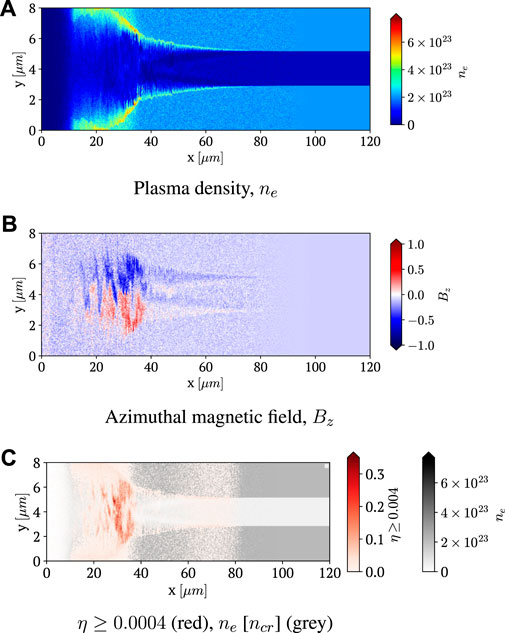
FIGURE 1. (A) Plasma electron density in the units of ncr, (B) azimuthal magnetic field strength Bz in units of B0 of the laser field and (C) Plasma electron density (grey) overlaid with emission parameter η ≥ 0.0004 (red) for a simulation with a laser pulse PL = 5 PW, τ = 40 fs and a0 = 350 hitting a planar target of C6+ plasma at around t ≈ 1400 fs.

FIGURE 2. Synchrotron emission parameter η along the symmetry axis (y =4 μm) of the plasma channel over time for simulations of a τ =40 fs laser pulse with incident power PL =5 PW and a normalized amplitude a0=350. The colorbar indicates the synchrotron emission power parameter η (6), and is limited to values up to ηmax =0.005 (higher values are depicted as ηmax) to enhance visibility.
The high-energy photon emission shows a broader angular distribution, albeit with the presence of two well-defined peaks situated around ±45° from the laser propagation direction in the channel as visible in Figure 3. From Figure 3, we can see that high-energy photons (≳ 50 MeV) are concentrated in these two peaks. This occurrence of two peak’s spectra has also been noted before for the case of linearly polarized laser pulse propagation in plasmas [10,37]. The physical reason for two lobes in the case of linearly polarized laser pulse stems from the fact that the laser field attains absolute maximum twice in a laser cycle, causing significant electron heating twice in the same laser cycle. This results in two distinct lobes of radiation emission. While in the case of a circularly polarized laser field, the maximum absolute electric field remains constant in a laser cycle and one only sees a single lobe of emitted radiation [12]. From now onwards, while discussing the properties of the γ-photon beams, we only consider photons emitted within one emission lobe at Φ = 45° ± 10°.
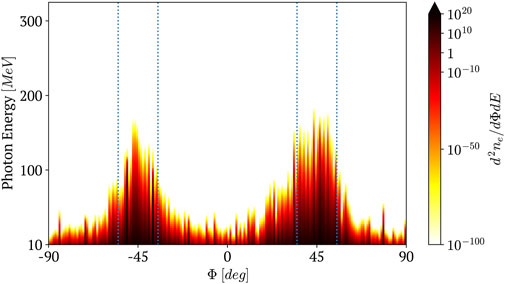
FIGURE 3. Angular distribution of the photon energy spectrum in degree with respect to the channel’s symmetric axis in MeV for a simulation with a laser pulse PL =5 PW, τ =40 fs, and a0=350, hitting a cylindrical target of C6+ plasma, averaged over the duration of the simulation. The dotted blue line indicates the beams defined as the emission cone at Φ =±45°±10°.
Figure 4 shows fractional efficiency of laser-to-photon energy conversion (ɛ) with the laser pulse duration for the incident laser power PL = 10 PW for the planar target. The choice of PL = 10 PW becomes clear later while comparing the brilliance of the photon beams. Evidently, the efficiency peaks for the laser pulse duration τ = 20 fs. This is attributed to plasma instabilities associated with the laser pulse propagation not being dominant for the short laser pulse duration of τ = 20 fs. However, for longer laser pulse duration, one can expect the generation of higher energy γ-photons. Thus, from now onwards, we show the γ-photons spectra for two laser pulse durations, for example, τ = 20 and τ = 40 fs.
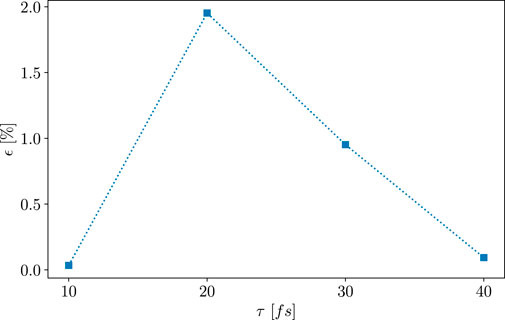
FIGURE 4. τ-scan for a 10 PW laser pulse with a0=350, regarding conversion efficiency into a collimated high-energy γ-ray beam
3.2 Planar target
Figure 5 shows the photon spectra generated for the different laser powers and pulse lengths. The maximum energy emitted by a photon increases with the incident laser power with maximum photon energy emitted
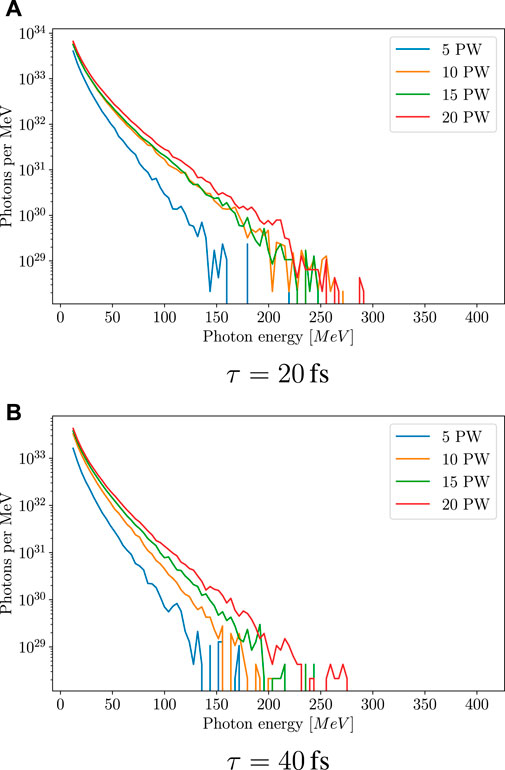
FIGURE 5. Photon emission spectra for photons with energies
To quantify the quality of the emissions regarding the collimated beams, we take a look at the two distinct radiation lobes as seen in Figure 3. Here, we consider all photons emitted with energies
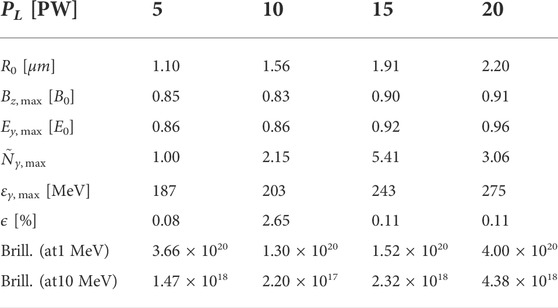
TABLE 1. Table of characteristic simulation results for the planar target with a0=350 laser pulse of duration τ =20 fs, rounded to second digit, except maximum photon energy ɛγ,max. Maximum values depict the overall maximum of that value during the whole simulation.
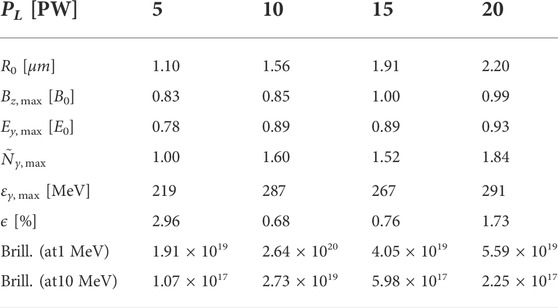
TABLE 2. Table for quantities as in Table 1 but for the laser pulse duration τ =40 fs. The normalized laser pulse amplitude remains the same a0=350 as in Table 1.
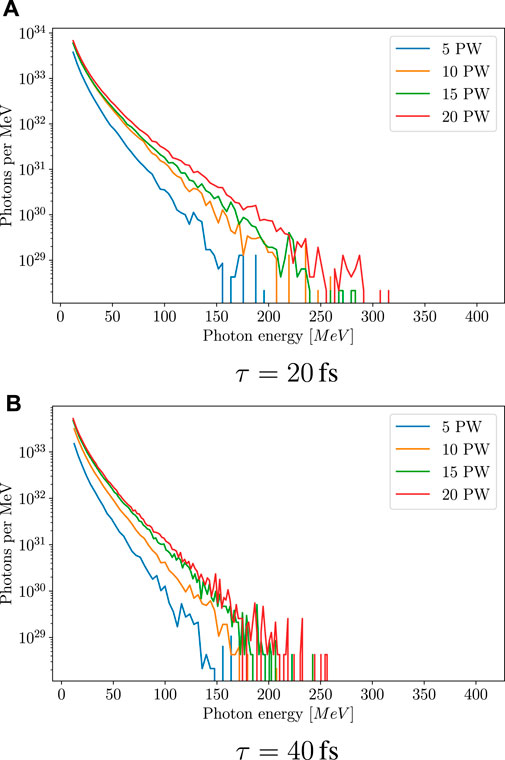
FIGURE 6. Photon emission spectra for photons with energies
3.3 Conical target
Figure 6 shows the photon energy spectra for a conical target. The total number of photons is of the same order of magnitude as for the planar target around
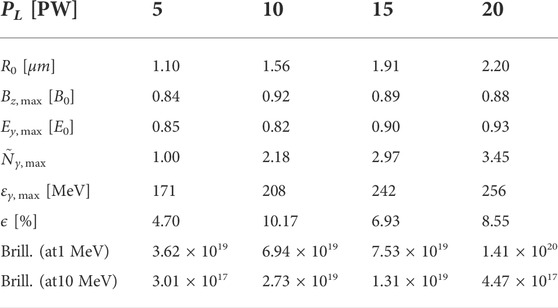
TABLE 3. Table of quantities for a conical target with a0=350 and the laser pulse duration τ =20 fs.

TABLE 4. Table of quantities for a conical target as in Table 3 but for the laser pulse duration τ =40 fs.
3.4 Comparison
Our results show similar trends as observed before for heavier plasma ions. For a more intense a0 = 468, λ = 1 μm pulse with a 15 fs duration using a structured target made of hydrogen plasma and pre-ionized gold [42] achieved brilliance levels of
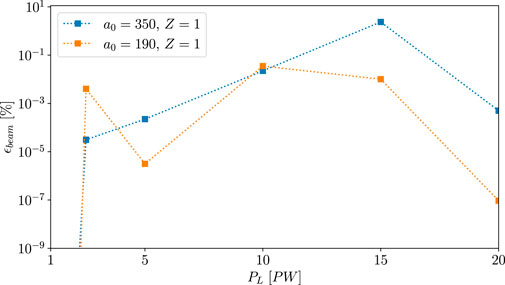
FIGURE 7. Conversion efficiency of the laser energy (τ =40 fs) impacting a Z =1 H+-plasma into a high-energy γ-ray beam
We also compare our results with theoretical predictions on maximum electron energies by Jirka et al. [36], who derived scalings on electron acceleration in the radiation-dominated regime in a plasma channel. As argued by Jirka et al. [36], radiation-reaction force can significantly alter the plasma electron dynamics, and in a best case scenario, electron acceleration to ultra-high energies can occur, as also studied earlier [2,3,9]. Thus, comparing the analytical scalings of electron acceleration by Jirka et al. [36] with the inferred values of the electron energies via synchrotron radiation emission in our simulations is instructive. In our simulations, the condition
Assuming these electrons emit photons by the well-known synchrotron emission, one can write
where ɛγ,max are the maximum measured photon energies as they are denoted in Tables 1 and Figure 3, and we assumed B ≈ B0, which is approximately in line with the observed field strengths. To compare the predictions with the observations, we plotted their ratio in Figure 8. Interestingly, for low-incident powers of p = 5 PW, our simulations yield photon energies that require electron energies to be
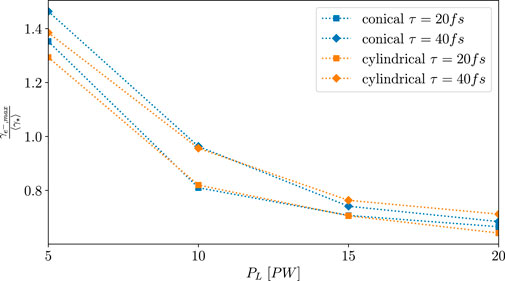
FIGURE 8. Ratio of predicted electron Lorentz factor γ⋆,max using Eq. 9 to γe,max the observed/measured Lorentz factor as function of incident power PL
4 Discussion and conclusion
We have shown that for incident laser powers (in the range 5–20 PW), one can efficiently convert the laser energy into the photon beams with energies up to
We find that the stronger Coulomb forces due to heavier carbon ions reduce the electron acceleration and photon energies compared to the case of hydrogen plasmas. Hence, our results for C6+-ion plasma (for τ = 40 fs, a0 = 350) are comparable to the results using a0 = 190 propagating in a hydrogen plasma channel as shown in Figure 7. Further, we show that the conical target in simulations yields higher laser-to-electron energy conversion efficiency, but it does not strongly improve the angular distribution of the generated photon beams and consequently, their brilliances.
To summarize, we have shown the generation of γ-ray beams with maximum brilliance exceeding 1020 s−1mm−1mrad−2 (0.1 %BW)−1 for τ = 20 fs for photons with 1 MeV explicitly favoring the shorter pulse length of 20 fs. We have investigated the generation of γ-photons for the laser power PL > 10 PW in the quantum-electrodynamics regime, where the photon generation is a stochastic effect. For further improvement, the impact of different target compositions, that is, solid shell for the channel instead of bulk plasma [37,42], might offer a way to further improve coupling between laser and plasma electrons as well as the guidance for the accelerated electrons, to improve the photon generation.
4.1 Permission to reuse and copyright
Figures, tables, and images will be published under a Creative Commons CC-BY license, and permission must be obtained for use of copyrighted material from other sources (including re-published/adapted/modified/partial figures and images from the internet). It is the responsibility of the authors to acquire the licenses, to follow any citation instructions requested by third-party rights holders, and cover any supplementary charges.
Data availability statement
The original contributions presented in the study are included in the article/Supplementary Material; further inquiries can be directed to the corresponding author.
Author contributions
NK conceived the project and suggested to CH. CH carried out and analyzed the PIC simulations and discussed the results with NK. NK carried out the theoretical analysis of the filamentation instability. Both authors contributed to the manuscript writing.
Acknowledgments
Results presented here are an extension of the bachelor thesis of CH, submitted to the Heidelberg University; Heppe [34].
Conflict of interest
The authors declare that the research was conducted in the absence of any commercial or financial relationships that could be construed as a potential conflict of interest.
Publisher’s note
All claims expressed in this article are solely those of the authors and do not necessarily represent those of their affiliated organizations, or those of the publisher, the editors, and the reviewers. Any product that may be evaluated in this article, or claim that may be made by its manufacturer, is not guaranteed or endorsed by the publisher.
Supplementary material
The Supplementary Material for this article can be found online at: https://www.frontiersin.org/articles/10.3389/fphy.2022.987830/full#supplementary-material
Abbreviations
2D, two-dimensional; PIC, particle-in-cell; keV, kilo electron volt; MeV, mega electron volt; PW, petawatt; FWHM, full-width at half-maximum; BW, bandwidth; MT, mega Tesla.
References
1. Mourou GA, Tajima T, Bulanov SV. Optics in the relativistic regime. Rev Mod Phys (2006) 78:309–71. doi:10.1103/revmodphys.78.309
2. Rousse A, Phuoc KT, Shah R, Pukhov A, Lefebvre E, Malka V, et al. Production of a kev x-ray beam from synchrotron radiation in relativistic laser-plasma interaction. Phys Rev Lett (2004) 93:135005. doi:10.1103/PhysRevLett.93.135005
3. Kumar N, Tripathi VK. Effect of betatron resonance on plasma wave acceleration of electrons in an ion channel. Europhys Lett (2006) 75:260–6. doi:10.1209/epl/i2006-10110-1
4. Liu C, Shen B, Zhang X, Ji L, Bu Z, Wang W, et al. Ultra-bright, well-collimated, gev gamma-ray production in the qed regime. Phys Plasmas (2018) 25:023107. doi:10.1063/1.5005077
5. Yu JQ, Hu RH, Gong Z, Ting A, Najmudin Z, Wu D, et al. The generation of collimated γ-ray pulse from the interaction between 10 pw laser and a narrow tube target. Appl Phys Lett (2018) 112:204103. doi:10.1063/1.5030942
6. Ji LL, Pukhov A, Nerush EN, Kostyukov IY, Shen BF, Akli KU. Energy partition, γ-ray emission, and radiation reaction in the near-quantum electrodynamical regime of laser-plasma interaction. Phys Plasmas (2014) 21:023109. doi:10.1063/1.4866014
7. Zhu X-L, Yin Y, Yu TP, Shao FQ, Ge ZY, Wang WQ, et al. Enhanced electron trapping and γ emission by ultra-intense laser irradiating a near-critical-density plasma filled gold cone. New J Phys (2015) 17:053039. doi:10.1088/1367-2630/17/5/053039
8. Stark D, Toncian T, Arefiev A. Enhanced multi-mev photon emission by a laser-driven electron beam in a self-generated magnetic field. Phys Rev Lett (2016) 116:185003. doi:10.1103/PhysRevLett.116.185003
9. Vranic M, Fonseca RA, Silva LO. Extremely intense laser-based electron acceleration in a plasma channel. Plasma Phys Control Fusion (2018) 60:034002. doi:10.1088/1361-6587/aaa36c
10. Jansen O, Wang T, Stark DJ, d’Humières E, Toncian T, Arefiev AV. Leveraging extreme laser-driven magnetic fields for gamma-ray generation and pair production. Plasma Phys Control Fusion (2018) 60:054006. doi:10.1088/1361-6587/aab222
11. Wang T, Ribeyre X, Gong Z, Jansen O, d’Humières E, Stutman D, et al. Power scaling for collimated γ-ray beams generated by structured laser-irradiated targets and its application to two-photon pair production. Phys Rev Appl (2020) 13:054024. doi:10.1103/PhysRevApplied.13.054024
12. Luedtke SV, Yin L, Labun LA, Labun OZ, Albright BJ, Bird RF, et al. Creating qed photon jets with present-day lasers. Phys Rev Res (2021) 3:L032061. doi:10.1103/PhysRevResearch.3.L032061
13. Huang TW, Zhou CT, Zhang H, Wu SZ, Qiao B, He XT, et al. Collimated gamma photon emission driven by pw laser pulse in a plasma density channel. Appl Phys Lett (2017) 110:021102. doi:10.1063/1.4973972
14. Corde S, Ta Phuoc K, Lambert G, Fitour R, Malka V, Rousse A, et al. Femtosecond x rays from laser-plasma accelerators. Rev Mod Phys (2013) 85:1–48. doi:10.1103/revmodphys.85.1
15. Mangles SPD, Walton BR, Tzoufras M, Najmudin Z, Clarke RJ, Dangor AE, et al. Electron acceleration in cavitated channels formed by a petawatt laser in low-density plasma. Phys Rev Lett (2005) 94:245001. doi:10.1103/PhysRevLett.94.245001
16. Ji Y, Li B, Duan T, Zhou W, Wu F, Zhang Z, et al. Effects of plasma density on laser-generated energetic electron generation and transport in a plasma channel. Phys Plasmas (2018) 25:063114. doi:10.1063/1.5021108
17. Kumar N, Hatsagortsyan KZ, Keitel CH. Radiation-reaction-force-induced nonlinear mixing of Raman sidebands of an ultraintense laser pulse in a plasma. Phys Rev Lett (2013) 111:105001. doi:10.1103/PhysRevLett.111.105001
18. Aléonard M, Altarelli M, Antici P, Apolonskiy A, Audebert P, Bartnik A, et al. WHITEBOOK ELI – extreme light infrastructure; science and Technology with ultra-intense lasers (andreas thoss). Berlin: THOSS Media GmbH (2011). doi:10.13140/2.1.1227.0889
19. Papadopoulos D, Zou J, Le Blanc C, Chériaux G, Georges P, Druon F, et al. The apollon 10 pw laser: Experimental and theoretical investigation of the temporal characteristics. High Pow Laser Sci Eng (2016) 4:e34. doi:10.1017/hpl.2016.34
20.[Dataset]. Xcels (2017). Available from: https://xcels.iapras.ru.
21.[Dataset]. Vulcan (2022). Available from: https://www.clf.stfc.ac.uk/Pages/Vulcan.aspx.
22. Derouillat J, Beck A, Pérez F, Vinci T, Chiaramello M, Grassi A, et al. Smilei : A collaborative, open-source, multi-purpose particle-in-cell code for plasma simulation. Comput Phys Commun (2018) 222:351–73. doi:10.1016/j.cpc.2017.09.024
23. Fischer J, Wegener M. Three-dimensional optical laser lithography beyond the diffraction limit. Laser Photon Rev (2013) 7:22–44. doi:10.1002/lpor.201100046
24.[Dataset]. The Monte Carlo algorithm for pair production, and related tables (2022). Available from: https://smileipic.github.io/Smilei/multiphoton_Breit_Wheeler.html (Accessed August 26, 2022).
25.[Dataset]. The Monte Carlo algorithm for photon emission, and radiation tables (2022). Available from: https://smileipic.github.io/Smilei/radiation_loss.html (Accessed August 26, 2022).
26. Nikishov A, Ritus V. Quantum processes in the field of a plane electromagnetic wave and in a constant field 1. Sov.Phys.JETP (1964) 1964:529–41.
27. Duclous R, Kirk JG, Bell AR. Monte Carlo calculations of pair production in high-intensity laser–plasma interactions. Plasma Phys Control Fusion (2010) 53:015009. doi:10.1088/0741-3335/53/1/015009
28. Kirk JG, Bell AR, Arka I. Pair production in counter-propagating laser beams. Plasma Phys Control Fusion (2009) 51:085008. doi:10.1088/0741-3335/51/8/085008
29. Lobet M, Ruyer C, Debayle A, d’Humières E, Grech M, Lemoine M, et al. Ultrafast synchrotron-enhanced thermalization of laser-driven colliding pair plasmas. Phys Rev Lett (2015) 115:215003. doi:10.1103/PhysRevLett.115.215003
30. Kaw P, Schmidt G, Wilcox T. Filamentation and trapping of electromagnetic radiation in plasmas. Phys Fluids (1973) 16:1522–5. doi:10.1063/1.1694552
31. Sheng ZM, Nishihara K, Honda T, Sentoku Y, Mima K, Bulanov SV. Anisotropic filamentation instability of intense laser beams in plasmas near the critical density. Phys Rev E (2001) 64:066409. doi:10.1103/PhysRevE.64.066409
32. Kumar N, Tripathi VK, Sawhney BK. Filamentation of a relativistic short pulse laser in a plasma. Phys Scr (2006) 73:659–62. doi:10.1088/0031-8949/73/6/021
33. Landau LD, Lifshitz EM. The classical theory of fields, vol. 2 of course of theoretical Physics. fourth revised english edn. Oxford, UK: Butterworth-Heinemann (2005).
34. Heppe C. Short-wavelength radiation generation in ultra-relativistic laser-plasma interaction (Bachelor Thesis). In: Tech. rep. Heidelberg, Germany: Max-Planck-Institute for Nuclear Physics and Universität Heidelberg (2020).
35. Kumar N, Karmakar A, Pukhov A, Shvets G. Interplay of collisions and temperature on the filamentary structures of a relativistic electron beam in plasmas. Eur Phys J D (2009) 55:415–20. doi:10.1140/epjd/e2009-00102-1
36. Jirka M, Vranic M, Grismayer T, Silva LO. Scaling laws for direct laser acceleration in a radiation-reaction dominated regime. New J Phys (2020) 22:083058. doi:10.1088/1367-2630/aba653
37. Xue K, Dou ZK, Wan F, Yu TP, Wang WM, Ren JR, et al. Generation of highly-polarized high-energy brilliant γ-rays via laser-plasma interaction. Matter Radiat Extremes (2020) 5:054402. doi:10.1063/5.0007734
38. Abramowicz H, Acosta U, Altarelli M, Aßmann R, Bai Z, Behnke T, et al. Conceptual design report for the luxe experiment. Eur Phys J Spec Top (2021) 230:2445–560. doi:10.1140/epjs/s11734-021-00249-z
39. He Y, Yeh IL, Blackburn TG, Arefiev A. A single-laser scheme for observation of linear breit–wheeler electron–positron pair creation. New J Phys (2021) 23:115005. doi:10.1088/1367-2630/ac3049
40. Kettle B, Hollatz D, Gerstmayr E, Samarin GM, Alejo A, Astbury S, et al. A laser–plasma platform for photon–photon physics: The two photon breit–wheeler process. New J Phys (2021) 23:115006. doi:10.1088/1367-2630/ac3048
41. Yu J, Zhou W, Cao L, Zhao Z, Cao L, Shan L, et al. Enhancement in coupling efficiency from laser to forward hot electrons by conical nanolayered targets. Appl Phys Lett (2012) 100:204101. doi:10.1063/1.4718735
42. Gu YJ, Klimo O, Bulanov SV, Weber S. Brilliant gamma-ray beam and electron–positron pair production by enhanced attosecond pulses. Commun Phys (2018) 1:93. doi:10.1038/s42005-018-0095-3
Keywords: laser–plasma interaction, particle-in-cell, γ-rays generation, laser-driven QED processes, radiation generation in plasmas
Citation: Heppe C and Kumar N (2022) High brilliance γ-ray generation from the laser interaction in a carbon plasma channel. Front. Phys. 10:987830. doi: 10.3389/fphy.2022.987830
Received: 06 July 2022; Accepted: 29 August 2022;
Published: 05 October 2022.
Edited by:
GuoBo Zhang, National University of Defense Technology, ChinaReviewed by:
Jianxun Liu, National University of Defense Technology, ChinaQian Zhao, Xi’an Jiaotong University, China
Wei-Yuan Liu, Shanghai Jiao Tong University, China
Copyright © 2022 Heppe and Kumar. This is an open-access article distributed under the terms of the Creative Commons Attribution License (CC BY). The use, distribution or reproduction in other forums is permitted, provided the original author(s) and the copyright owner(s) are credited and that the original publication in this journal is cited, in accordance with accepted academic practice. No use, distribution or reproduction is permitted which does not comply with these terms.
*Correspondence: Naveen Kumar, bmF2ZWVuLmt1bWFyQG1waS1oZC5tcGcuZGU=
 Christian Heppe
Christian Heppe Naveen Kumar
Naveen Kumar